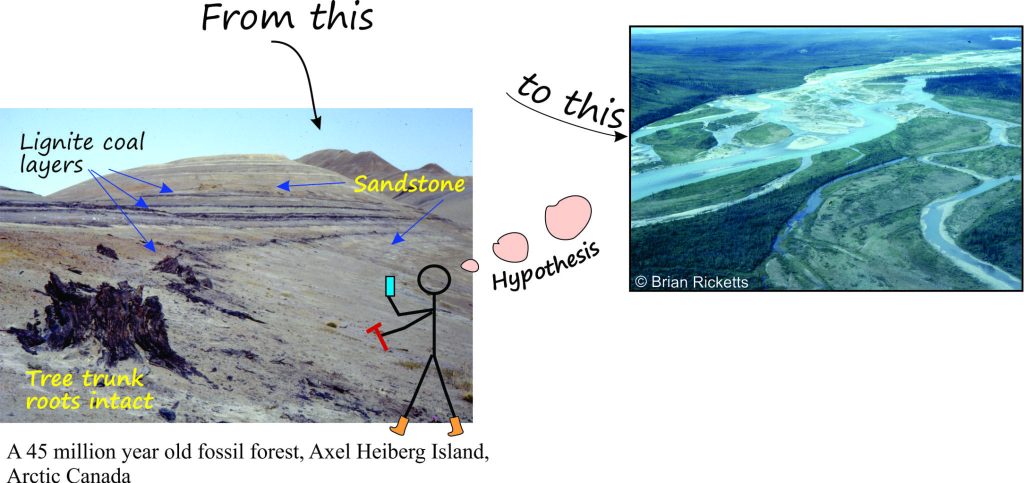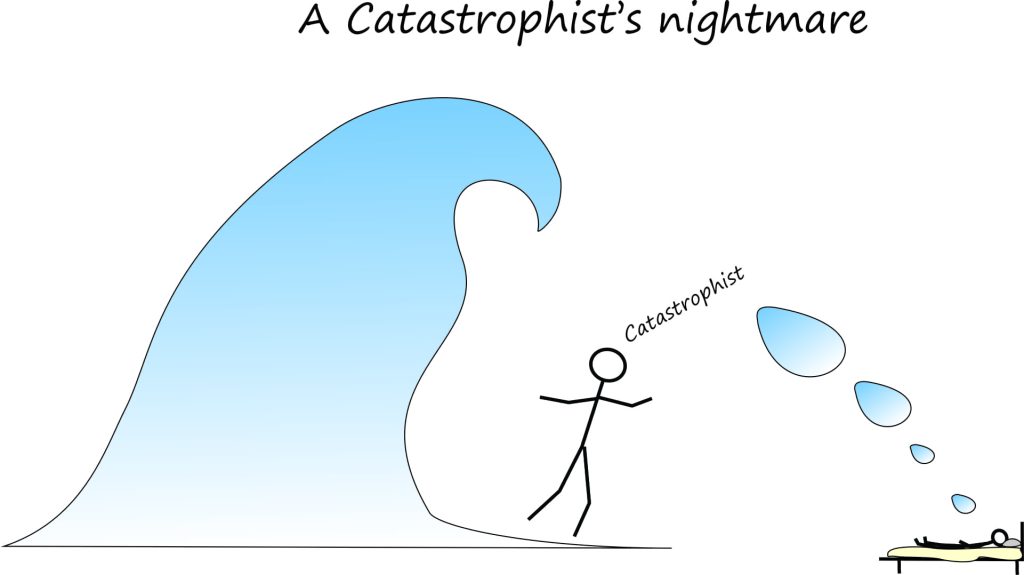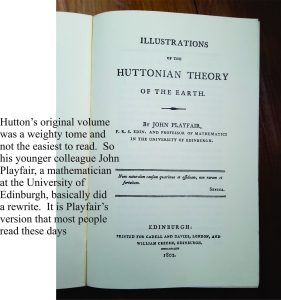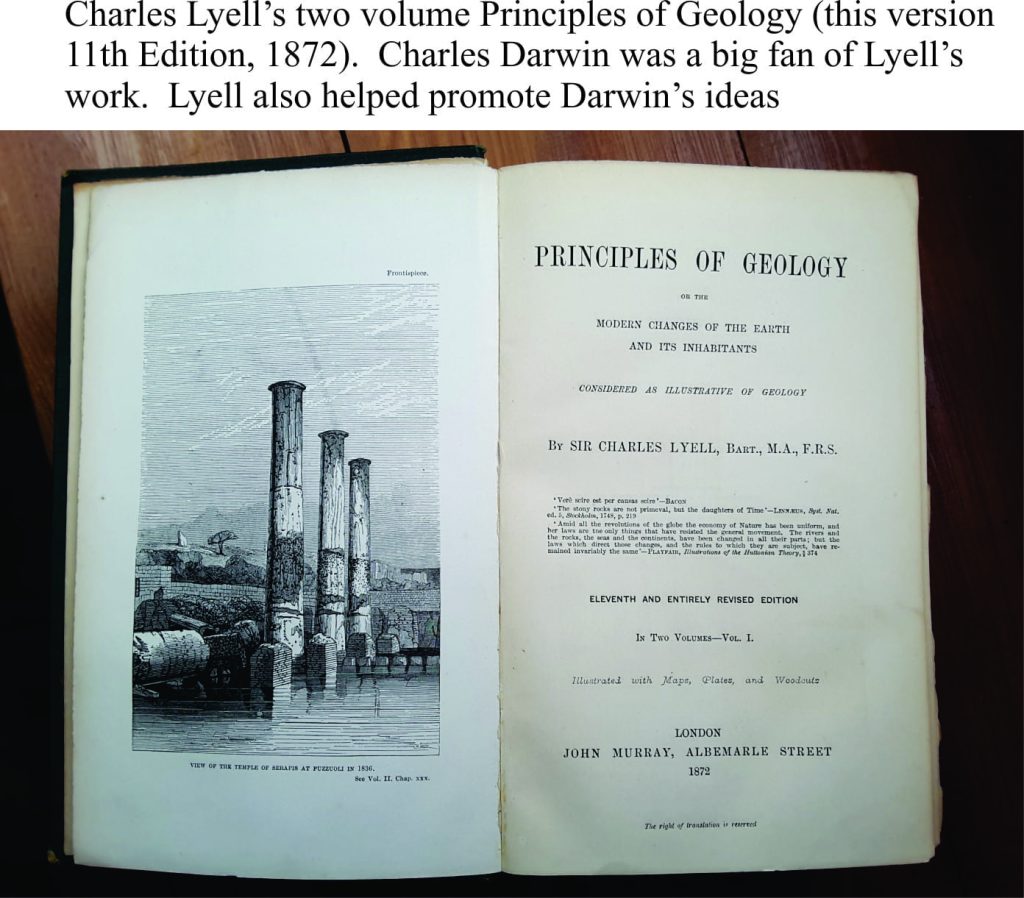How Geologists Interpret Ancient Environments. 3 A Philosophical Interlude
You are confronted by a rocky cliff and your geologist friend tells you that these rocks formed originally in rivers that flowed through a wooded valley. How did your buddy come to this conclusion?

The first two posts in this series dealt with the order in which layers of sediment accumulate (stratigraphy), and with some of the structures we observe that help us interpret ancient environments. But what is the principle that guides us through this process: how do we get from observing structures in rocks to an hypothesis, a picture or image of meandering rivers and picturesque woods?
Most geologists will answer this question with the statement “The Present is the Key to the Past”. This expression of how we might view the world (universe) has probably been quoted a million times, in every Introductory Geology course over the last century. It is attributed to Scottish Geologist Archibald Geikie (1905), but it has its roots in 18th Century science. To understand what this principle does for us we need to have a quick look at these historical roots.
The Principle of Uniformity
The prevailing thought, one might even say dictate, during most of the 17th and 18th centuries was that earth was no older than about 6000 years according to calculations by Bishop Ussher. The processes that form landscapes, volcanoes and mountain belts were also thought of as Catastrophic, a concept that has its roots in biblical stories like Noah’s flood.

Of course we now know, as did naturalists and theologians in the 17th and 18th centuries (they were commonly the same people), that some processes are catastrophic – volcanic eruptions and tsunamis can wreak havoc. But they are not the most important processes that shape our world.

James Hutton, regarded by most as the “father” (perhaps founder is a better word) of modern geology, presented in 1785 to the Royal Society of Edinburgh, his contrary thoughts on how the earth formed. Hutton understood that the Earth was really old. This conclusions was based on lengthy observation of natural processes. He could find “… no vestige of a beginning, no prospect of an end”. This is a profound statement. For Hutton geological time was immense. It had to be immense because the processes he observed (that produce landscapes) worked inexorably slowly from a human perspective – like watching paint dry. Hutton’s ideas were the complete antithesis of Catastrophism.
One of the most important of Hutton’s corollaries was that the natural processes resulting in landscapes, mountain belts and oceans progressed with the same intensity and as uniformly in the distant past as they do today. This statement has had a profound influence on geology in particular and science in general ever since. This is the concept of Uniformity.
Hutton’s ideas had a mixed reception. The Catastrophists and theologians alike saw it as a serious challenge to the status quo, especially as a challenge to biblical scholarship. Enter Sir Charles Lyell, friend and mentor of Charles Darwin, who popularized the concept of uniformity in his Principles of Geology (1830). Lyell was an

important figure in British scientific circles and couldn’t be ignored. Uniformity was in ascendancy, to the extent that a contemporary of Lyell’s, William Whewell coined the term Uniformitarianism (in 1832). This name has stuck ever since – a pity because it is a real mouthful.
Hutton’s ideas were central to Charles Lyell’s celebrated books – Principles of Geology, the first volume being published in 1830. Here, Lyell coined a phrase that still resonates through the geological world – “The Present is the Key to the Past.” The phrase is also encapsulated in the extended title to Lyell’s volumes: Being an Inquiry How Far The Former Changes of the Earth’s Surface are Referable to Causes now in Operation. Nowadays, most earth science folk use this statement of the principle. The terms Uniformitarianism and Catastrophism, that represent two competing views of how the physical world formed, have since been consigned to history (but are no less important because of that).
How does “The Present is the Key to the Past” aka. Uniformitarianism, help us?
Basically it means we can use processes in the present physical, chemical and biological world (universe) to help us decipher the ancient world. The previous post ‘Ruffles and Desiccation’ is a good example of this reasoning. In that example we see structures in ancient sedimentary rocks (crossbeds and cracks) that we explain by using modern analogues and examples (ripples and mud cracks). We can apply our knowledge of how and where ripples (and mud cracks) form to interpret these ancient structures. We may observe such processes directly in nature, or attempt to reproduce them in the laboratory where we can also monitor all manner of experimental variables. The principle applies to all aspects of science – chemistry, physics, and biology. It is profound!
However, we can also look at the principle The Present is the Key to the Past in a more general way. The late Stephen J. Gould, eminent paleontologist and polymath, in an essay published in 1965 (Is Uniformitarianism Necessary?; American Journal of Science, volume 263, pages 223-228), argued that the principle gives us a warrant to reason inductively; to create ideas and images, interpretations, predictions, to enter the world of discovery. In other words the principle becomes part of our methodology or way of thinking. I really like Gould’s analysis.
Logically we can also turn this principle around; The Past is the Key to the Future. Basically this states that the analysis and understanding of the ancient world can help us predict future conditions. For example, the science that guides our understanding of Climate Change, a subject that the scientific community currently spends a great deal of time and energy on, relies in part on our understanding of paleoclimates (i.e. climates in the geological past), how they changed, why they changed and how quickly they changed.

















